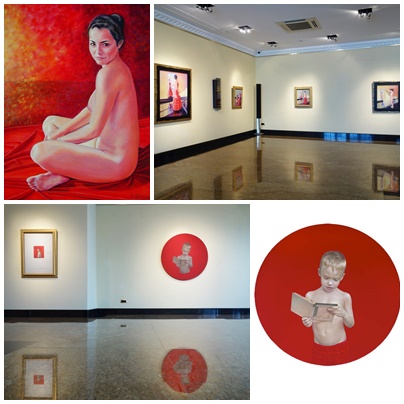"F2 Figurative figure"Salustiano García, Conchi Álvarez

STOA GALLERY
Puerto de Estepona- Port Edificio Puertosol 1ª planta-First floor, Of. 24 -29680 Estepona Malaga SpainTel: 0034951318426 Fax: 0034952798284 e-mail:


February 1st > April 13th, 2018

|
The exhibition focuses on the figure as the theme, and on the figurative as a means of expressing that content. A contemporary review and interpretation of an eternal theme: the human figure.
Salustiano, great master of the pictorial art, has a well-deserved international recognition. The two works present in "F2" have as their object of view, in both cases, the childhood. Dominating the room, bright and spectacular, the tondo "Juanito reading", distills an unequivocal reminiscence to the most elegant Renaissance, more classical, with a composition of fourteenth century invocation, in which the most dazzling red achieved from eight pigments blinds us, a flat red that covers the background and overflows it, because it rubs off on the clothes. This manages to isolate the naked torso of the infant, of superlative three-dimensionality, as a break of glory of the 21st century. In this way, “Juanito reading” becomes a legend, as it becomes a new iconographic type, that of a small warlord reader. This Renaissance atmosphere is increased, even more, with the second work of art, a small engraving, also of the red series, in which, in this case, a girl with a naked torso and with a hairpiece typical of a character from Piero della Francesca. "Engulfed" by the purple background, she traps us with her beautiful and solemn look.
Conchi Álvarez, a painter of extensive international experience, brings to the exhibition her vision of the female figure with works of art from her series on female ritual. Each oil painting describes an episode of the narrative in which the universal feminine insecurity is overcome through a protocol, almost liturgical, which, in this case, is that of the Flamenco woman. Beautiful female nudes run through the exhibition, no doubt beyond the viewer's gaze. Women performing a ritual in which garments and accessories have an order and function, fixed for generations. And in the end, the announced victory, the dreamed prize, the achieved beauty. In the artwork, "La bien plantaá", a woman sure of herself, intoxicated by her prowess, proudly displays an unsurpassed final aspect.
Salustiano, great master of the pictorial art, has a well-deserved international recognition. The two works present in "F2" have as their object of view, in both cases, the childhood. Dominating the room, bright and spectacular, the tondo "Juanito reading", distills an unequivocal reminiscence to the most elegant Renaissance, more classical, with a composition of fourteenth century invocation, in which the most dazzling red achieved from eight pigments blinds us, a flat red that covers the background and overflows it, because it rubs off on the clothes. This manages to isolate the naked torso of the infant, of superlative three-dimensionality, as a break of glory of the 21st century. In this way, “Juanito reading” becomes a legend, as it becomes a new iconographic type, that of a small warlord reader. This Renaissance atmosphere is increased, even more, with the second work of art, a small engraving, also of the red series, in which, in this case, a girl with a naked torso and with a hairpiece typical of a character from Piero della Francesca. "Engulfed" by the purple background, she traps us with her beautiful and solemn look.
Conchi Álvarez, a painter of extensive international experience, brings to the exhibition her vision of the female figure with works of art from her series on female ritual. Each oil painting describes an episode of the narrative in which the universal feminine insecurity is overcome through a protocol, almost liturgical, which, in this case, is that of the Flamenco woman. Beautiful female nudes run through the exhibition, no doubt beyond the viewer's gaze. Women performing a ritual in which garments and accessories have an order and function, fixed for generations. And in the end, the announced victory, the dreamed prize, the achieved beauty. In the artwork, "La bien plantaá", a woman sure of herself, intoxicated by her prowess, proudly displays an unsurpassed final aspect.








